





Experts from our small grains and cover crops teams recently put their heads together and decided that since farmers who are interested in winter grains may also be interested in cover crops and vice versa, it may be more convenient for you to have one catalog that combines our broad lineup of cover crops with our extensive lineup of winter grains. We want to make it as easy as possible for you to find the seed you need to round out even the most diverse crop rotation, and we can’t wait to work with you to leverage the collective strength of these lineups on your farm.
Albert Lea Seed’s commitment to diversified agriculture goes back to day one. In 1923, Lou Ehrhardt started selling seed out of Gulbrandson's hardware in downtown Albert Lea, Minnesota. He sold Grimm alfalfa, Hubam clover, Danish sludstrup and Mangel beets, Marquis wheat, sudangrass, flax, peas, oats, Dwarf Essex rapeseed, MN13 open-pollinated field corn, and a relatively new forage crop called Habaro Soy Beans. A century later, we’re proud to still offer one of the largest selections of farm crops and cover crop seed in the nation.
We’re excited by the groundswell of interest that regenerative ag has experienced over the last several
years. Working with you every day and focusing on adapting to your needs has positioned us as a go-to source for diverse solutions and knowledge to support your efforts. No matter how you define regenerative ag—or how long you’ve been applying these practices—we’re committed to your success. You can count on us for high quality seed and information to help you be productive, while being a good steward of the land and a strong advocate of soil health. This is a responsibility we don’t take lightly.
Based on insights from customers, we continue to add more products to better meet your needs. This year we’ve expanded our cover crops by creating a premium brassica forage mix, BrassicaMax CC4, and our winter grains lineup includes a range of new hybrid rye and winter wheat varieties. Please let us know of anything you’d like to see us develop.

Whether you’re thinking about becoming a customer, you’ve worked with us for generations, or you’re somewhere in between, we appreciate you. Thank you for your business! We’re 100 years in and continue to innovate to meet your needs. We look forward to serving you and future generations for the next century and beyond.
Winter wheat is a versatile species that can be used for grain, straw, and as a cover crop to break weed and pest cycles. A 12-year University of Illinois study found that winter wheat added as a third rotational crop to a corn-soybean rotation boosted corn yields by 10 bushels/acre and soybeans by 5 bushels/acre. Winter wheat provides an excellent window for seeding cover crops after grain harvest.
Grain, Cover Crop, Forage Most soil types; avoid very poorly drained soils
• Winter wheat needs sufficient available N (and other nutrients) to support the yield target. Many conventional producers split-apply N for a total of 1.5-2.5 units per bu. of yield target.
Sept. 10 – Oct. 10 in southern MN (date range will change as you move north or south)
• Avoid planting winter wheat on corn ground or wheat stubble because it increases the risk of fusarium head blight (scab).
• If wheat must follow corn or corn silage, remove or bury the corn residue to reduce risk of fusarium infection.
• Planting past optimum seeding date increases the risk of winterkill and reduces yield.
• Seeding too early can result in excessive fall growth, making plants more vulnerable to winterkill and acts as a green bridge for pests.
• Watch herbicide rotation restrictions.
100-140 lbs/acre drilled 1" to 2" deep Optimum final stand is 900,000-1,000,000 plants/acre
SD Midland, Viking 211, and Winner data from 2022 UMN variety trials. Expedition data from 2022 SDSU variety trials.
LC3334 and Erisman data from UW and MSU 2021 variety trials.
Viking 801 and Viking 822 agronomic ratings from genetic originator.
Viking 801 yield data from 2022 UW variety trials.
Winter Hardiness/Test Weight/Protein 1=highest, 9=lowest;
Maturity 1=early, 9=late;
Rust/Scab 1=most resistant, 9=least resistant;
Lodging 1=least prone, 9=most prone; ID Insufficient Data
UTILIZING SEED COUNT VS. LBS
While traditional agronomic advice relied on lbs or bu / acre for seeding rate, it is much more accurate to calculate seeding rate by seed count, germination and purity.
Use the following formula to arrive at your target seeding rate: Seeding rate in pounds per acre = [desired stand / (1 - expected stand loss)] / [seeds per pound x percent germination]
The optimum stand of winter wheat is 900,000 to 1,000,000 plants per acre or 21 to 23 plants per square foot. The optimum stand is less than hard red spring wheat (HRSW) because the crop will have more opportunity to tiller in both the fall and early spring. Increase the desired stand to 23-25 plants per square feet when planting is delayed or if seedbed conditions are unfavorable for rapid emergence.
Learn more: https://bit.ly/umnwheatseed

• Older variety with consistent winterhardiness and grain quality
• Good baking and excellent milling quality
• Excellent standing, good choice for high management and fertile soils
• Early maturity, medium height
• Released by SDSU
Available as: Conventional Organic
NEW
• Excellent yield potential (second highest yielding wheat in three-year average, South Dakota statewide)
• Slightly taller, semi-dwarf with very good standability
• Outstanding milling & baking quality, received the U.S. Wheat Quality Council 2021 Millers Best of Show Award
• Very good disease resistance to FHB; susceptible to leaf & stem rusts
• Released by SDSU
Available as: Conventional
• Highest-yielding HRWW we sell
• Great all-around characteristics for conventional and organic farmers
• Tall & very good standing; late-heading
• Very good test weight; above average protein
• Great all-around disease tolerance, including excellent tolerance to FHB
• Excellent performance across HRWW growing areas from 2019-2021
Available as: Conventional Organic
• Highest 3-year statewide average in 2022 U of MN Winter Wheat Trials (80.6 bu/acre)
• From SDSU breeding program
• Tall, but with good standability
• Good baking quality
Available as: Conventional
• Variety developed for organic producers by U of IL and named after long-time organic grower, Jack Erisman
• Early maturing, high yielding, and excellent disease resistance to fusarium head blight and stripe rust
• Excellent field and University results, strong yields, heavy test weight
• Very good milling & baking quality grain
• Wide adaptability to variable soil types
Available as: Organic
• Good combination of grain quality, yield and scab tolerance
• Medium-tall, very good straw strength, smooth heads
• Above-average test weight, protein, and grain quality
• Medium to early maturity; good standing
• Excellent tolerance to rust & fusarium head blight
Available as: Organic
• Very high-yielding (5-10% more than LCS3334)
• Genetic resistance to fusarium head blight (Fhb1 gene)
• Medium-tall height, good standing
• Good emergence and early maturing
• Broadly adapted to central and northeastern SRWW growing areas
Available as: Organic
• Very well-adapted from northern TX and east across the southern U.S.; excellent on-farm performance
• Specifically selected for organic farmers for its resistance to Fusarium Head Blight (Scab) and to Stripe and Leaf Rust
• Medium-early variety but later heading
• Excellent standability; medium-tall height
• Very good disease resistance package to rusts & fusarium head blight (Fhb1 gene for scab tolerance)
• Awned variety with excellent all-around agronomics
• In 2020 trials, 822 yielded: 116% of avg. (N. TX), 113% of Avg. (AR), 106% of Avg. (LA), 106% (N. GA), 104% of Avg. (MD)
Available as: Organic
**Requires a license agreement
Winter Rye is the most cold-hardy winter grain, germinating down to 35˚F. It can be grazed deep into the fall, out competes weeds, and produces lots of forage or green manure in the spring. It performs better than other winter grains on low fertility and/or droughty soils. It has excellent feed value as a forage. Average grain yields range from 35-50 bu/acre.
Cover Crop, Fall/ Spring Forage, Grain
All soil types & environments
Planting Date
Sept - Nov 15 (depending on intended use)
Winter rye fertilization should be managed to match its intended use.
A cover crop of rye does not require any added N fertilizer, forage rye may require from 40-80 lbs. of N, and a highinput crop of hybrid rye could require up to 150 lbs. of N depending on: a). previous crop, b). expected yield, and c). soil organic matter.
When growing as a cover crop, terminate winter rye at least 10 days to 2 weeks before planting cash crops in the spring. No-tilling into winter rye can also be a viable system in the Upper Midwest with careful management.

For Cover Crop: Drill, broadcast or fly-on 50 - 75 lbs/acre. Time broadcast/aerial seedings with forecasted rains into field corn, sweet corn or soybeans at beginning of leaf senescence (yellowing) in the fall.
For Forage/Grain: Drill open-pollinated varieties at 100 lbs/ acre 1 to 1 ½" deep. It is possible to get a poor stand from seeding rye too deep.
For Roll-Down System: Drill 120 - 150 lbs/acre. Early, accurate planting in fall is critical for best establishment, tillering and biomass production in the spring.
• Economical choice for forage, grain, or cover cropping
• Northern origin
Available as: Conventional
• Canadian variety; no license requirement
• Among highest yielding OP varieties available
• Excellent yield potential; matures late
• Shorter height, good standability
Available as: Conventional Organic
• Early-heading variety; popular choice for organic, no-till, rolldown systems
• Very tall, high biomass variety; good winter hardiness
• Good spring recovery, early-season vigor
• Will head out earlier than other winter rye varieties
• High lodging potential, thinner stems
Available as: Conventional Organic
• Polish variety with very high yields, heavy test weight, and large, plump kernels
• Good milling/distilling characteristics for an OP variety
• Good winter hardiness and standability
• Well recognized in Canada and increasingly popular in US
• Great spring biomass production
Available as: Conventional Organic
• Very tall, early-maturing variety that may replace Aroostook
• Excellent winter hardiness
• Higher seed yields and more biomass accumulation vs. Aroostook
• Requires license before delivery/pickup
• Good candidate to trial in the organic no-till roll down system or as a forage crop
• Released by NDSU
Available as: Conventional Organic
• Bred to maximize the benefits of winter rye as a cover-crop
• Outstanding emergence and early biomass growth in the spring
• Utilize seeding rates and dates for standard VNS Rye
• Not suitable for grain production (contains a trace of winter wheat)
*Variety not stated
**Requires a license agreement
Available as: Conventional
All data from University of Minnesota, 2022 (except Aroostook, PFI/ISU, 2022). Winter Hardiness: 1=very hardy, 9=not hardy; Straw Strength/Protein: 1=best, 9=worst; Ergot: 1=resistant, 9= susceptible; Test Weight: 1=heaviest, 9=lightest; ID=insufficient data; NA=not applicable
Hybrid Winter Rye is bred to produce the highest-yielding rye cereal grain and forage with low incidence of disease. Hybrid rye performs well in drought conditions and on sandy soils and even better on more productive soils.

• Excellent winter hardiness
• Superior grain quality for milling, distilling, and feed markets
• Rye can be fed in rations for dairy, beef, and swine
• All hybrid rye varieties require a signed license; grain cannot be saved for seed
• Plants are shorter, stand well, and are more uniform in height and maturity than open-pollinated rye varieties
Higher yield: Can yield up to 90 - 160 bu/acre (up to 100% more than open-pollinated varieties).
Disease resistant: All varieties have reduced risk for ergot with proper management, and have very low incidence of other diseases such as fusarium head blight and leaf and stripe rust.
Reduced CO2 emissions: Scientific studies demonstrate that hybrid rye feed mixes can decrease CO2 emissions in pork production by more than 20 percent.
Grain, Fall/ Spring Forage
All soil types & environments
Sept. 1 – Oct. 10 (varies with latitude & elevation)
• Higher management than open-pollinated rye
• Optimal planting date, planting depth, fertility, and in-season management is critical for maximum performance
• Provide 1.2 lbs of available N per bushel of targeted grain yield
Plant 800,000 viable seeds/acre, 1" deep and not deeper. In southern Minnesota, optimum seeding time is September and can continue into October farther south. Uniform seed spacing enables optimum tiller development. Avoid seeding hybrid rye after October in southern Minnesota. Optimal crop residue management and down pressure in high residue situations is important for proper seeding depth and winter survival.
Hybrid Rye is sold as a 1,000,000 Seed Unit. Tote bags generally contain 25 units, and paper bags contain ½ unit (500,000 seeds)
KWS Hybrid Rye requires a signed license agreement before pickup or delivery. You can e-sign a license on our website, or we can email you a link. Visit our website for more production information.
• Highest yielding; well suited to productive soil
• Adapted for feed use, milling, and distilling
• Excellent standability
• Position on heavier soils north of I-90
• Avoid late planting for this hybrid
Available as: Conventional Organic
• Excellent drought tolerance; best dryland variety but suited for all soil types
• Replaces KWS Bono
• Earliest heading hybrid rye (up to a week earlier than other varieties)
• Best protection for ergot in the hybrid rye lineup
• Adapted to Midwestern states
Available as: Conventional
• Consistent, all-around performance
• Performs in low-input environments
• Well adapted for feed, milling, and distilling uses
• Can succeed on varied soil types; excellent East/West movement
• Forage type for whole-plant silage or grazing
• Tall; very high dry matter yields
• More tons and milk/acre than triticale; earlier heading
• Harvest at boot stage for best balance of quality and yield
• Late heading; consider for organic no-till roll down systems
Available as: Conventional
**
• Forage type for whole-plant silage or grazing
• Tall; very high dry matter yields
• More tons and milk/acre than triticale; heads out at similar dates
• Harvest at boot or milk stage; holds lower leaves and forage quality better through milk stage than Progas
Available as: Conventional
Available as: Conventional
Progas data from KWS, 2022. All other data from University of Minnesota, 2022. Winter Hardiness: 1=very hardy, 9=not hardy; Straw Strength/Protein: 1=best, 9=worst; Ergot: 1=resistant, 9= susceptible; Test Weight: 1=heaviest, 9=lightest; NA=not applicable
*Variety not stated **Requires a license agreement
Compared to spring barley, winter barley is typically harvested significantly earlier, has higher yields, fewer disease issues, lower input needs, and provides more erosion prevention and nutrient scavenging.

Although winter barley has shown excellent promise as a productive feed and malting grain for the Upper Midwest, winter survival can be inconsistent in MN, WI, SD, ND and northern IA. However, breeding efforts at UMN have resulted in much more winter hardy varietals like MN-Equinox. Planting early and getting good snow cover (for insulation) are both critical to winter barley survival in the north central U.S. Plant in sheltered areas to help improve winter survivability.
Grain, Forage, Malting
All soil types; sheltered fields likely fare best
Anheuser-Busch Contract For Change
ID (Organic)
Moorhead, MN (Malt Plant) ID, MT, ND (Grain Elevators) jessica.newman@ anheuser-busch.com
Proximity Malt
Colorado, Delaware, Wisconsin proximitymalt.com • 414-755-8388
John Anderson John.a@proximitymalt.com
Aug 15 – Sept 15 (time seeding after Hessian fly-free date when possible)
80-100 lbs. per acre, drilled to a depth of 1" at a row spacing of 7.5" Optimal stand is 1.25 – 1.6 million plants/acre
Preferred Varieties: LCS Violetta, LCS Genie
Rahr Malting Shakopee, MN rahrcorporation.com • 952-445-1431
Ron Volpi • rvolpi@rahr.com
Contract Method: Pre-contract
Preferred Varieties: AAC Synergy, Pinnacle, Explorer, Lacey
Briess Malting Chilton, WI briess.com • 920-849-7711
Joe Tulius joe.tulius@briess.com
Contract Method: Pre-contract, spot market
Preferred Varieties: ACC Synergy, Pinnacle
Maltwerks
Detroit Lakes, MN maltwerks.com • 218 844-6258
Randy Peterson ⁄ Kaj Peterson randy@maltwerks.com kaj@maltwerks.com
Contract Method: Spot market
Preferred Varieties: ACC Synergy
Malteurop Milwaukee, WI malteuropmaltingco.com/en 844-546-6258
Contract Method:
Pre-contract, spot market
Preferred Varieties: Mayflower, Voyager
Vertical Malt Crookston, MN verticalmalt.com
701-203-3358
Adam Wagner
Contract Method: Does not purchase Preferred Varieties: ND Genesis, ACC Synergy
Two Track Malting Bismark, ND twotrackmalting.com 701-595-3388
Future farmers in a seed field of MN Equinox Barley (Hampton, MN)• German variety bred for superior malt quality
• Early maturing and short height
• Good disease resistance
• Strong yield potential
• Good east/west movement in zones 5 & 6
Available as:
**Requires a license agreement
• Excellent yield potential
• Early maturity, medium height
• Excellent standability and disease resistance
• Awnless for improved feed quality
• Good winter hardiness in zone 5 and south in 2018-2021
Available as: Organic
• Six-row, facultative winter barley for animal feed released by U of MN
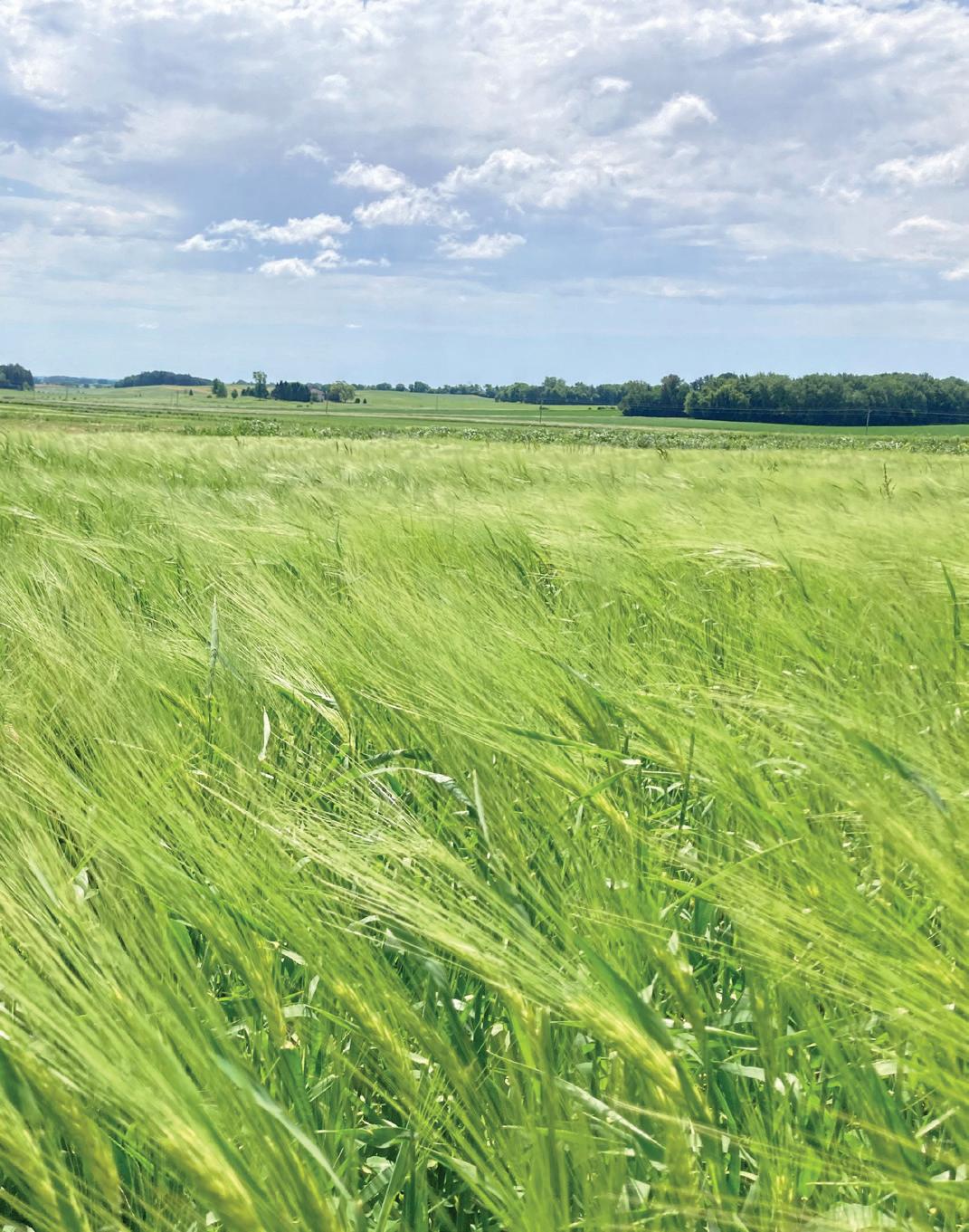
• Bred for superior winter hardiness in the upper Midwest; good on-farm winter survival
• Very early maturing
• Facultative characteristics; can be planted in fall or spring and makes grain
• Standability deteriorates after maturity; ensure timely harvest
• Moderately susceptible to spot blotch, especially when spring-planted
Available as: Organic
• Best winter survival rating among 28 winter barleys tested across 23 environments in 2019-2020
• New German 6-row winter barley for feed
• Very high yields (averaged 124 Bu. across 23 locations in 2019-2020)
• Very good standability
• Good leaf disease resistance
Available as: Conventional
Looking for Spring Barley? See page 22.
LCS Violetta and KWS Orbit data from Cornell University, 2022. All other data from University of Minnesota, 2022. Scab 1=resistant; 9=susceptible. ID=Insufficient Data.
Winter Triticale is a cross between winter wheat and winter rye that combines the high yield potential, grain quality, and disease resistance of winter wheat with the winter hardiness and lower fertility requirements of winter rye.

Maintains the best forage quality, particularly if harvesting is delayed, of all the winter grains. Cut before heading for best forage quality.
Best Use Adaptations Planting Date
Forage, Cover Crop, Grain
Requirements
All soil types Sept 1 – Oct 15
ORGANIC TULUS TRITICALE Ridgeway, Wisconsin
Triticale is often less winter hardy than winter rye. Plant early for best overwintering potential.
Seeding
100 lbs/acre (forage, grain)
• Outyielded all open-pollinated rye varieties in 2022 Iowa trials (PFI and ISU) at Kanawha and Greenfield
• Grain-specific, low-ergot variety with excellent yield potential
• Good winter hardiness and suitability for variable soils
Available as: Conventional Organic
• Very high-yielding forage triticale

• Nearly awnless, <5% awn expression
• Taller & earlier maturing
• Adaptable to variable growing regions (including dryland)
Available as: Conventional Organic
MAY 6
JUNE 11
TULUS TRITICALE GRAIN YIELD PERFORMANCE AT MULTIPLE LOCATIONS ACROSS MINNESOTA AND IOWA IN 2022.
Will you have more FX1001 available this year? It seemed to be much hardier than what the neighbors were growing and matured about one and a half weeks sooner! The best triticale in our area. Had a lot of positive comments from neighbors who noticed the difference. It yielded 3.0 to 3.5 tons dry matter, and I was just very happy with that variety and its ability to handle tough conditions.
– CENTERVILLE, IA –
Winter Spelt, a subspecies of wheat, is a new crop for us. We have added it to our lineup because you have been asking for it! Often used as an animal feed (both for grain and forage), it is growing in popularity in human food (after the removal of the hulls) because some people with wheat intolerance are able to eat spelt products.
Livestock feed as hull-on grain, hay/ silage (comparable to triticale). When de-hulled can be used as flour in human food.
Requirements
All soil types; can handle heavy wet soils better than wheat and is also a better competitor against spring weeds. Less prone to lodging than other spelt varieties.
Similar to winter wheat, after the fly-free date in your area. (Sept. 10 – Oct. 10 in southern MN; date range will change as you move north or south)
• Heritage variety with taller growth habit and late maturity
• Tall height, shades out weeds better than modern varieties
• Lower yielding than modern varieties
• Can tolerate poor soils because of extensive root system
• Seed threshes free of hull like modern wheats
• Unique rich and complex flavor with excellent baking qualities
• Seed 100-120 lbs/acre in early spring
Available as: Organic
• Should be rotated with other, non-grain crops
• Generally more winterhardy than SRWW; we recommend testing these on your farm on a limited acreage
• Seed will come with the hull on, and should be seeded that way
• Fertility similar to wheat except for nitrogen (75-90lbs N/A); can be split applied in the fall and spring
Seeding
150-180 lbs./acre at least 1 inch deep
NEW
• New northern European winter spelt
• Very high yield potential
• Medium maturity, good standing, medium height variety
• Awned variety with reddish grain
• MR to septoria, powdery mildew and leaf rust; susceptible to FHB
Available as: Organic
ORGANIC ZOLLERNFELT SPELT
• New northern European winter spelt with food-use potential
• Excellent grain quality, high protein
• High yield potential
• Medium maturity, very good standing, short variety
• Awned variety with red grain
• MS to Septoria, rust, and powdery mildew; susceptible to FHB
Available as: Organic
• First commercially-viable, perennial grain crop, released by U of MN in partnership with The Land Institute
• Larger seed size and seed retention than typical perennial intermediate wheatgrass varieties; good lodging resistance
• Extensive, deep root system and perennial growth recycles nutrients, sequesters carbon and aids in water infiltration
• Typically produces top grain yields for two years, with drop-off thereafter **Grower must have license from The Land Institute to purchase and plant Kernza—no exceptions—visit kernza.org/growers for more information.
Planting Dates
Aug. 15 - Sept. 1
Seeding 10-15 lbs. per acre (~12 lbs/acre PLS) Seed ½" deep using a Brillion or drill
Available as: Conventional
Wendy Johnson inspects her field of MN Clearwater Kernza (Northeast IA)

Diversity is key for building soil health, and with diversity comes complexity. This new world of seeding complex cover crop mixes includes drilling, seeding with air delivery systems, and broadcast (either by airplane or drone)—and it requires special effort to get the seeding rate right.
People often ask, "How should I set up my drill for cocktail mixtures? Should I set it for the largest seed in the mix?" Before calibrating your drill, consider:
Mixes with lower seeding rates (25-30 lbs/acre or fewer) are usually comprised of small seeds that typically can flow through the grass-seed attachment box on the drill. Examples include our ValueMax (CC2), BrassicaMax (CC4), MultiMax (CC7), Cultivation Max (CC8), Plowdown Blend (CC9) , and Corn Builder (CC12).
Mixes calling for higher seeding rates (30 lbs/acre or more) include some large-seeded species, such as rye, peas, or buckwheat. Seed these through the large seed box. Examples include our NitroMax (CC1), Winter Max (CC3), AerialMax (CC5), SummerMax (CC6), DiverseMax (CC10), FixNMax (CC11), and Pollinator Max (CC13).
Seed size Influences seeding depth. We suggest you seed at a depth ideal for the mid-sized seeds in your mix. This may plant some small seed a bit deep and some large seed a bit shallow.
Mixes including small seed tend to sort in the box, with small, dense seeds dropping to the bottom. Throughout seeding, either partially fill the box at each "refill" or periodically stop and remix the seed within the box.

Drill settings on seeding rate charts are calibrated for single species. Using these settings as a starting point, there are ways to make adjustments and determine the best setting for a diverse cover crop mix.
Find the setting for the largest-sized seed in your mix— for example, peas—to deliver the seeding rate (e.g. 50 lbs/A). Since smaller seeds in your mix will readily flow out of the metered openings, resulting in MORE than 50 lbs/A delivered, you’ll need to make an adjustment. Cut that seeding rate back by 1/3 to 1/2 for a first calibration run.
For example, if you want to deliver 50 lbs/A of cover crop mix including peas, note the pea setting for 50 lbs/A and cut back to a setting to deliver 25 to 37 lbs/A.
At this point, there is a series of "trial runs" needed to zero in on the actual drill setting to deliver the 50 lbs/A of your mix.
For more details on three methods of calibrating your drill to deliver your target seeding rate, visit our website.
Reminder: As with any crop, you may want to purchase an extra bag or two of your premixed or custom cover crop mix, (depending on your acres to be planted) to allow for calibration and potential overplanting.
THERESA PEDRETTI, COVER CROP SPECIALIST | MARGARET SMITH, PHD, FORAGE AGRONOMISTDiverse Blend for Coverage
Maximize fall soil coverage & green manure production after early-harvested crops like small grains, sweet corn, vegetables, corn silage, or early soybeans.
Conventional Mix Components
42% Spring Small Grain
55% Field Peas
3% TapMaster Radish
Organic Mix Components
42% Organic Spring Small Grain
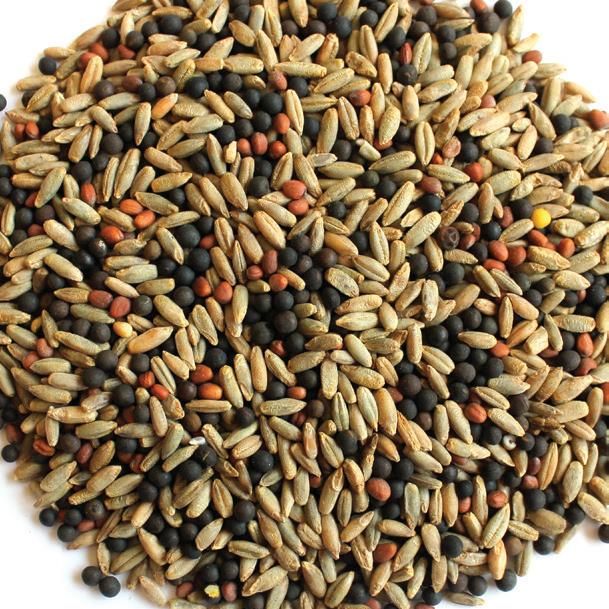

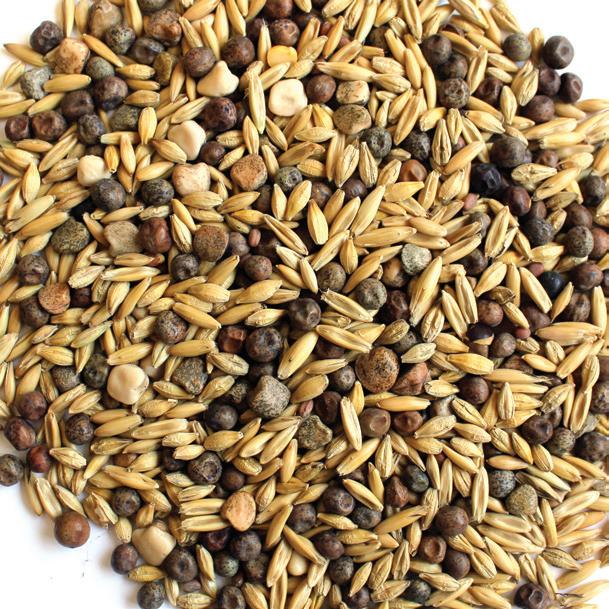
55% Organic Field Peas
3% Organic TapMaster Radish
• Excellent for weed suppression
• Good scavenger of nutrients
• Excellent fall growth and biomass
• Not good fit after full-season grain corn or soybeans due to shortened growing season
• Will likely winterkill in Upper Midwest
• Inoculate with: Exceed Pea/Vetch
Planting Date
Aug. 1 – Sept. 15
Seeding
75-100 lbs/acre at ½” deep. Drill for best results. Avoid aerial application; peas need soil coverage.
Available as: Conventional Organic
High Seeds Per Lb
Diverse combination of small-seeded cover crops to build healthy soils, fix nitrogen, and sequester nutrients.
Conventional Mix Components
60% RootMax Annual Ryegrass
20% Crimson Clover
15% TapMaster Radish
5% Dwarf Essex Rapeseed
Organic Mix Components
60% Organic Annual Ryegrass
20% Organic Crimson Clover
20% Organic TapMaster Radish
• Annual ryegrass adds biomass & weed competition; clover fixes N; radish breaks up compacted soil; rapeseed provides quick cover
• Can establish under shade & crop canopy with adequate moisture; suitable for interseeding into corn at V4-V6
• Suitable for grazing in the fall
• Not good fit after full-season grain corn or soybeans due to shortened growing season
Planting Date
Last cultivation or Aug. 1 – Sept. 15
Seeding
15-20 lbs/acre at ¼” to ½” deep. Drill, broadcast, or aerial apply into standing crops in fall or interseed into corn at V4-V6. Later seeding reduces clover & brassica growth.
Available as: Conventional Organic
Winter Hardy & Soil Benefits
Our most winter-hardy blend combines the hardiness and aggressiveness of winter rye, the N-fixation potential of hairy vetch, and the deep soil penetration of radishes with a small touch of camelina.
Conventional Mix Components
80% Winter Rye
15% Hairy Vetch
3% TapMaster Radish
2% Winter Camelina
Organic Mix Components
80% Organic Winter Rye
15% Organic Hairy Vetch
5% Organic TapMaster Radish
• Winter-hardy species for excellent biomass and soil coverage in fall & spring
• Plant after small grains, vegetables, corn silage, or early soybeans
• Can be planted after grain corn or soybeans but hairy vetch/radish growth will be minimal
• Winter rye, hairy vetch and camelina in this diverse blend reliably winter over in Upper Midwest
• Inoculate with: Exceed Pea/Vetch
Planting Date
Aug. 1 – Oct. 1
Seeding
50-75 lbs/acre at ¼” to ½” deep. Drill, broadcast or aerial.
Available as: Conventional Organic
All mixes subject to change based on availability.
Economical mixture of improved brassica species designed for high-quality fall grazing, weed competition and soil building. Highly digestible & nutrient-rich blend provides leaves & bulbs that cattle, sheep & other grazing animals can utilize well into the fall & early winter.
Conventional Mix Components
30% Barsica Forage Rapeseed
30% Forage Kale
20% Barkant Forage Turnip
20% Pasja Hybrid Brassica
• Each species in mix selected for high forage yield and digestibility
• High seeds/lb and low cost make this an excellent choice for fall forage
• Excellent fit after hayfield termination, small grains, sweet corn or silage corn
• Seed with 1.5 bu oats/acre or 1 bu/acre spring barley or wheat for even more tonnage and increased fiber content of the mix. Succeeds on small grain ground where you can expect volunteer growth.
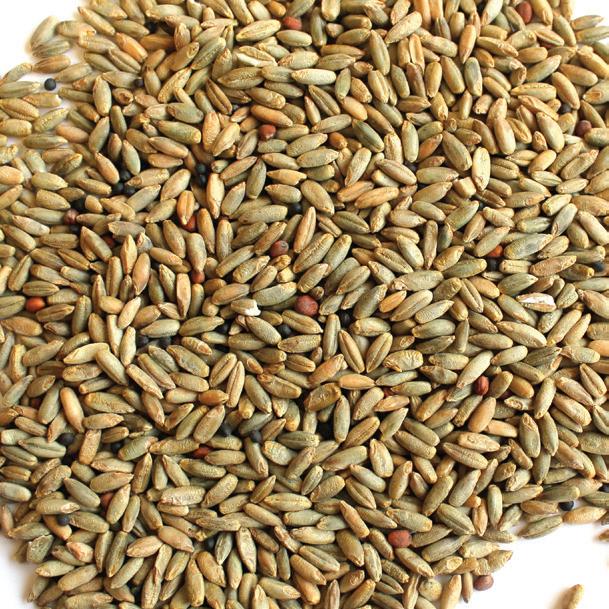
• Introduce grazing animals to heavy brassica stands slowly to avoid feeding issues or fill them up on dry hay first before grazing
Planting Date
Aug. 1 – Sept. 15
Seeding
5-6 lbs/acre drilled or 8-9 lbs/acre broadcast or aerially. Seed ¼” to ½” deep.
Available as: Conventional
Formulated for aerial application into standing corn or soybeans. Mix diversity provides excellent fall/early spring soil coverage.
Conventional Mix Components
95% Winter Rye
2% TapMaster Radish
2% Dwarf Essex Rapeseed
1% Winter Camelina
• Best results when flown on or applied prior to corn dieback (at or before black layer) or at soybean leaf yellowing before leaf drop
• Winter rye and camelina reliably over winter; rapeseed and radish will likely winterkill
Planting Date
Aug. 1 – Sept. 30. Depending on your hardiness zone, this mix can be planted later than range but later planting will lessen growth of radish and rape.
Seeding
50-75 lbs/acre at ½” deep. Drill, broadcast or aerial apply. Time your fly-on with a predicted rain for best establishment success.
Available as: Conventional
Maximum Warm-Season Tonnage
Vigorous, warm-season mix of summer annual grasses, broadleaves, and legumes for maximum summer growth, weed suppression, and soil building.
Conventional Mix Components
20% Buckwheat
20% Cowpeas
20% Cover Crop Oats
10% Japanese Millet
10% Sorghum-Sudangrass
10% Sunn Hemp
5% Sunflowers
5% Dwarf Essex Rapeseed
Organic Mix Components
30% Organic Buckwheat
25% Organic Soybeans
15% Organic Sorghum Sudangrass
15% Organic Blackeyed Cowpeas
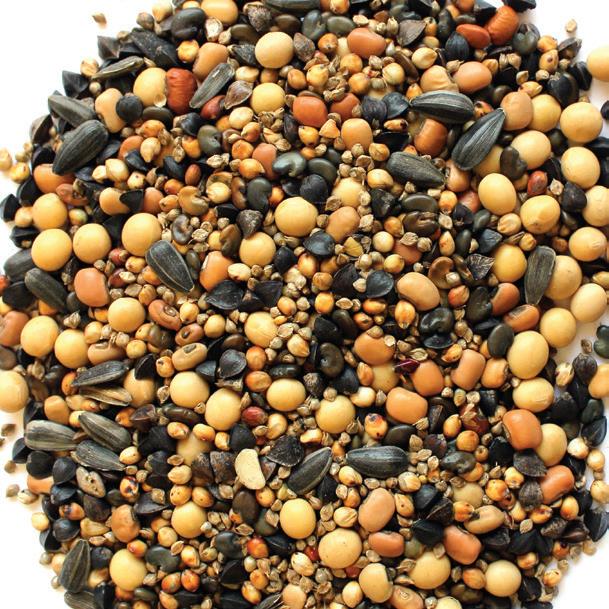

15% Organic Cover Crop Oats
• Ideal for summer fallow soil building, prevented planting situations or for summer grazing & forage
• Tremendous biomass out competes weeds
• Terminate or cut/graze prior to buckwheat and/or sunn hemp flowering
• Sunn hemp seed can be toxic to livestock; remove livestock at sunn hemp flowering
• Inoculate with Exceed Cowpea/Sunn Hemp
Planting Date
May 30 – Aug. 15 after risk of frost has passed.
Seeding
40-50 lbs/acre at ½” deep. Drill for best results.
Available as: Conventional Organic
All mixes subject to change based on availability.
Adaptable & Diverse
Very diverse and cost-effective blend of grasses, legumes, and brassicas. Smaller seed size and high seeds/lb. provide premium return for low cost.

Conventional Mix Components
45% Annual Ryegrass
20% Crimson Clover
20% Berseem Clover
4% Ethiopian Cabbage
4% TapMaster Radish
4% Purple Top Turnips
3% Dwarf Essex Rapeseed
• Can establish under shade and crop canopy with adequate moisture
• Excellent for seeding into standing crops at V4V6 or in late summer-early fall (time with rain)
• Well adapted to all soil types and conditions; not good fit after full-season grain corn or soybeans due to shortened growing season
• Will likely winterkill in the Upper Midwest
• Small-seeded legumes are pre-inoculated
Planting Date
Last cultivation; Aug. 1 – Sept. 15.
Seeding
15-20 lbs/acre at ¼” to ½” deep. Drill, broadcast or aerial apply.
Available as: Conventional
Shade-tolerant blend of organic cover crop species specially formulated for seeding at last cultivation in corn (V4-V6 stage).
Organic Mix Components
40% Organic Annual Ryegrass
40% Organic Mammoth Red Clover
20% Organic TapMasterRadish
• Small-seeded mix for companion planting with corn at last cultivation
• Emerges and stays semi-dormant until corn dies back in fall
• Not recommended for interseeding into soybeans, as canopy is shady; best suited for medium- to heavy-textured soils; will likely struggle on sandy soils without irrigation
• Best establishment achieved when drilled or incorporated vs broadcast
• Small-seeded legumes are pre-inoculated
Planting Date
June 1 – July 5, V4-V6/last cultivation will depend on planting date and corn maturity
Seeding
12-15 lbs/acre at ¼” to ½” deep. Time with rain at seeding. Drill or broadcast.
Available as: Organic
Your Small Grain Companion
Most popular for underseeding with small grains. Produces abundant biomass and fixes nitrogen for the following cash crop. Positions your fields well for corn the following year.
Organic Mix Components
30% Organic Mammoth Red Clover
30% Organic Yellow Blossom Sweetclover
20% Organic Hardy Alfalfa
20% Organic Alsike Clover
• Adapted to varying soil types and field conditions
• Excellent fit for underseeding spring small grains or frost seeding into winter small grains
• Can fix 50-100+ lbs. N/acre: legumes will be at peak N-fixation potential at flowering in the spring following seeding year
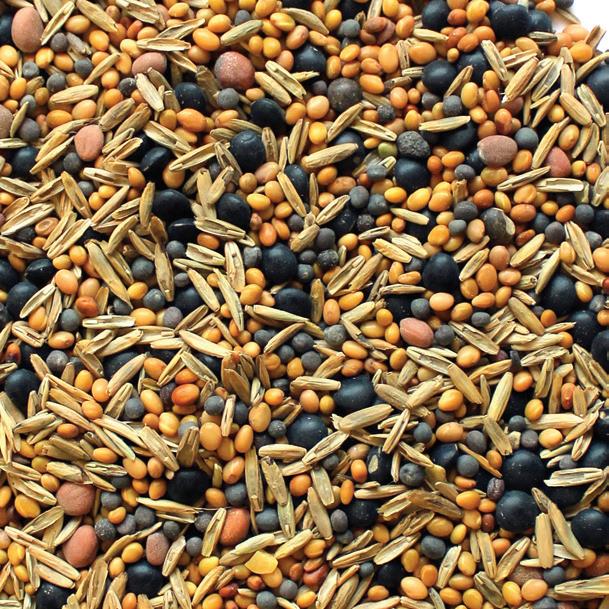
• Not a good choice for haying due to potential for sweetclover toxicity
• Allow to grow into the following spring for maximum N benefit
• Small-seeded legumes are pre-inoculated
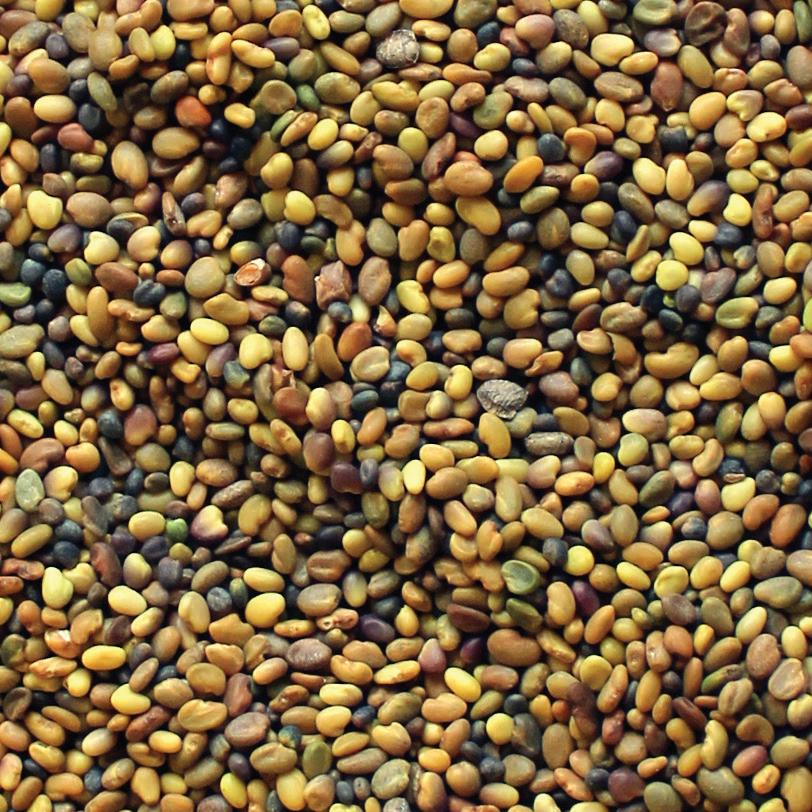
Planting Date
Feb. – May; Aug. 1 – Aug. 15
Seeding
12-15 lbs/acre at ¼” to ½” deep. Drill or broadcast.
Available as: Organic
Our most diverse mix. Maintains vigorous growth over wide range of soils, weather conditions and growing seasons.
Conventional Mix Components
25% Cover Crop Oats
10% Chickling Vetch
10% Annual Ryegrass
10% Sunn Hemp
10% Berseem Clover
10% Common Vetch
10% Buckwheat
5% Sorghum-Sudangrass

5% Lentil
2.5% TapMaster Radish
2.5% Dwarf Essex Rapeseed
• Warm & cool season species for versatility
• Plant after small grains, peas or sweet corn
• Diverse mix for longer planting window
• Will likely winterkill in Upper Midwest
• Not a good fit after full- season crops
• Inoculate with Exceed Pea/Vetch and Cowpea/ Mung Bean/Sunn Hemp
Planting Date
June 1 – Sept. 1
Seeding
40-50 lbs/acre at ½” to ¾” deep. Drill for best results.
Available as: Conventional
Maximize nitrogen fixation with this diverse blend! Best fit after small grains harvest; will complement volunteer small grains.
Conventional Mix Components
25% Field Peas
25% Chickling Vetch
20% Faba Beans
15% Hairy Vetch
10% Lentils
5% TapMaster Radish
Organic Mix Components
50% Organic Field Peas
30% Organic Lentils


15% Organic Hairy Vetch
5% Organic TapMaster Radish
• Blend of cool season legumes & brassicas for maximum fall N production and retention
• Radish for quick establishment & nurse crop
• Plant in late summer or early fall following small grains, peas, sweet corn or vegetables
• Hairy vetch overwinters; other species will likely winterkill in the Upper Midwest
• Inoculate with Exceed Pea/Vetch
Planting Date
Aug. 1 – Sept. 15
Seeding
60-75 lbs/acre at ½” to ¾” deep. Drill for best results.
Available as: Conventional Organic
Three small-seeded legumes with excellent N-fixing capabilities.
Conventional Mix Components
60% Nitrogen Brand (non-dormant) Alfalfa
20% Medium Red Clover
20% Berseem Clover
• Alfalfa and berseem clover will likely winterkill in Upper Midwest: red clover should over winter
• Potential for high quality hay cutting in seeding year plus enough regrowth for fall/ spring plowdown.
• Harvesting for forage crop without enough time/moisture for adequate regrowth will limit nitrogen benefit for following crops
• Weather conditions will impact growth rate and height of underseeding mix; don’t delay small grain harvest as alfalfa and berseem clover will continue to grow up into plant canopy
• Small-seeded legumes are pre-inoculated
Planting Date
Spring-seeded with a small grain
Seeding
12-15 lbs/acre drilled at 1/4” to 3/8” deep.
Available as: Conventional
All mixes subject to change based on availability.
Abundant Floral Resources
Fast establishing annual mixture that will attract beneficial insects. Contains a diverse selection of species that will add a splash of color to your farm, while also supporting pollinators and beneficial predator species.


Conventional Mix Components
20% Oats
20% Buckwheat
15% Cowpeas
15% Field Peas
6% Partridge Peas

5% Flax
5% Radish
3% Berseem Clover
3% Crimson Clover
3% Phacelia
3% Sunflowers
2% Rapeseed
• Provides floral resources, habitat and refuge throughout growing season
• Drill or broadcast in spring and terminate at end of season
• Some species will flower and set seed, requiring management of volunteers in subsequent years
• The species included are not known to be invasive, though some (e.g. buckwheat) can become competitive weeds in production fields
• For best success, inoculate with Exceed pea vetch, and Exceed Cowpea/Mung Bean/ Sunn Hemp; small-seeded legumes are pre-inoculated


• This mix was developed with feedback from the Xerces Society
Planting Date
May 15 - June 15
Seeding
40-50 lbs/acre. Drill or broadcast and incorporate.
Available as: Conventional
YOUR CUSTOM MIX
Whatever Works Best on Your Farm
Couldn't find what you were looking for? Let us make the perfect mix for your farming operation. Give us a call at 800.352.5247 to get started.
• Our signature Daikon variety bred for long taproot to mitigate compaction, sequester nutrients, and compete with weeds
• Consistent from year-to-year, unlike VNS Radish
• Excellent scavenger of N, P & Ca
• Non-bolting if planted in the fall
• Will likely winterkill in Upper Midwest
Seeding
6-8 lbs/acre at ¼" to ½" deep. Drill or increase rate to broadcast seed.
Available as: Conventional Organic
• Vigorous taproot accumulates leachable nutrients, protects soil, improves infiltration, and mitigates compaction
• Adapted to most soil types
• Plants break down completely by spring; no need for fall or spring tillage.
• Will likely winterkill in Upper Midwest
Seeding
6-8 lbs/acre at ¼" to ½" deep. Drill or increase rate to broadcast seed.
Available as: Conventional
• Late-maturing rape with short stems and very large leaves
• Produces high-quality forage
• Produces much high forage yields than Dwarf Essex
• Good as stand alone crop or in mixes of clover, turnips, small grains, and other brassicas
Seeding 4-7 lbs/acre at ¼" to ½" deep. Drill or increase rate to broadcast seed.
Available as: Conventional
• Succulent, leafy & quick-growing
• Rapid, vigorous growth; low cost, and high seeds/lb
• Performs better than radishes for aerial application in dry soil conditions
• Will likely winterkill in Upper Midwest Seeding 4-7 lbs/acre at ¼" to ½" deep. Drill or increase rate to broadcast seed.
Available as: Conventional
• Improved variety: 50% more dry matter than purple top turnip and almost five times the leaf production
• Ideally suited for grazing with sheep and cattle
Seeding
3-5 lbs/acre at ¼" to ½" deep. Drill or increase rate to broadcast seed.
Available as: Conventional
• Hardy, leafy, large-rooted; produces biomass above and below ground
• Excellent fall grazing potential
• Scavenges N and other nutrients which prevents leaching
• Should winterkill in Upper Midwest
Seeding
3-5 lbs/acre at ¼" to ½" deep. Drill or increase rate to broadcast seed.
Available as: Conventional
• Blend of two of our popular brassica species
• Two types of root systems make an excellent soil building plow down mix
• Excellent for fall grazing
Seeding 4-7 lbs/acre at ¼" to ½" deep. Drill or increase rate to broadcast seed.
Available as: Organic
* Variety Not Stated
• Open leaf cabbage for cover crop or grazing
• Deep-growing tap roots reduce soil compaction and break up hardpans
• Excellent nutrient scavenging ability
• Outstanding bolt resistance for early fall planting
• Will likely winterkill in Upper Midwest
Seeding
3-4 lbs/acre at ¼" to ½" deep. Drill or increase rate to broadcast seed.
Available as: Conventional
• Unique brassica that will not bolt until undergoing a cold, vernalization period
• Will remain vegetative throughout summer months
• More shade tolerant than other brassica species
Seeding
6-8 lbs/acre at ¼’’ to ½’’ inch deep. Drill or increase rate to broadcast seed.
Available as: Conventional
• Our most cold-tolerant choice for grazing
• Highly palatable; graze late into fall
• Frost-tolerant; livestock often prefer kale after freezing
• Will likely winterkill in Upper Midwest
Seeding
3-4 lbs/acre at ¼" to ½" deep. Drill or increase rate to broadcast seed.
Available as: Conventional
• Fast-growing, high yield forage brassica
• Allow 6 weeks to establish, then can be grazed at monthly intervals
• Great heat and drought tolerance
• All leaf and no stem; leaves grow from the plant crown
• Very palatable
Seeding
4-6 lbs/acre at ¼’’ to ½’’ deep. Drill or increase rate to broadcast seed.
Available as: Conventional
• Fall-seeded, winter annual brassica excellent for cover cropping
• Winter hardiness similar to winter rye; consistently overwinters
• Excellent nutrient scavenger
• Can be grown as a cover crop or taken to oilseed harvest in late June
• Plant after soybean harvest, before corn in crop rotation
• Seed is small and dense, tends to sort in mixture
Seeding
6-10 lbs/acre at ¼" to ½" deep. Drill or increase rate to broadcast seed.
Available as: Conventional
• Good fit if frost-seeded before soybeans or flown on in fall
• Performs best when seeded alone; not recommended in mixes
• Fast growing, potential for smother crop

• Control plant at first flower to avoid seed set and unwanted volunteers
Seeding
15-20 lbs/acre at ½" to ¾" deep. Drill or increase rate to broadcast seed.
Available as: Conventional
• Most economical grass for cover cropping
• Rapid growing with an extensive root system that builds soil structure and holds soil in place
• Excellent as green manure or single-year forage crop
• Well adapted to heavier soil types
• Will likely winterkill in northern zones
• May overwinter if planted early, with adequate snow cover or if the winter is mild
Seeding
15-20 lbs/acre at ¼” to ½” deep. Drill or increase rate to broadcast seed.
Available as: Conventional Organic
• Consistent winterkill and better weed competition vs. VNS
• Variety selected for consistent winterkill in northern hardiness zones; can survive the winter in USDA winter hardiness zone 5 and warmer
• Diploid variety selected for increased tillering for faster ground cover in the fall
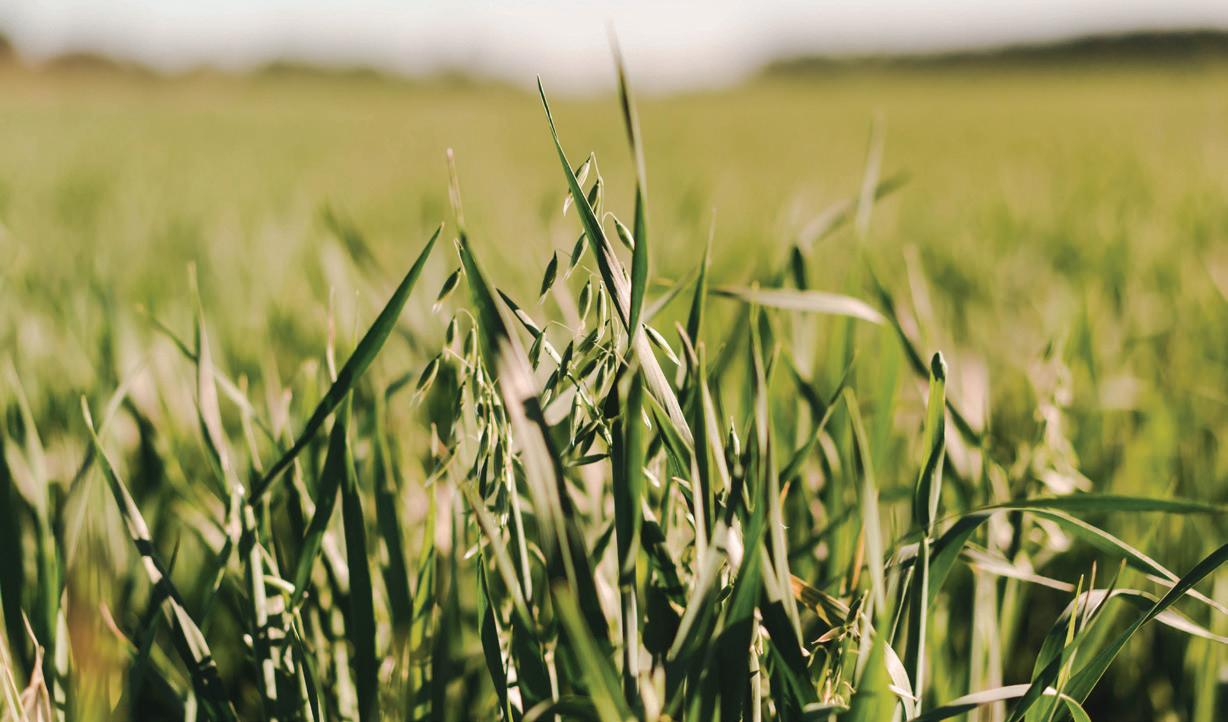
• Extensive roots, excellent nutrient scavenging and good palatability as forage
• Good candidate for low-altitude aerial application and well adapted to varying soil types
• Can be seeded at last cultivation/V6 or flown on in standing corn or soybeans
Seeding
15-20 lbs/acre at ¼” to ½” deep. Drill or increase rate to broadcast seed.
Available as: Conventional
• An economical small grain option for cover cropping
• Excellent for fall forage and grazing
Seeding
48-96 lbs/acre at ½" to ¾" deep. Drill or increase rate to broadcast seed.
Available as: Conventional Organic
• Fast establishing with abundant biomass; competitive with weeds
• Excellent biomass production and fall forage potential
• Fibrous root system builds soil structure and captures excess nutrients
• Easy to control; fits many rotations
• Oats will winterkill
Seeding
32-96 lbs/acre at ½" to ¾" deep. Drill or increase rate to broadcast seed.
Available as: Conventional Organic
• Excellent cold tolerance; rapid growth and very competitive with weeds
• Extensive root system
• Faster establishing than spring oats in the fall
• Won't overwinter in northern zones; acts as winter annual in Zones 7+
• Excellent forage quality, low lignin and will not head out if fall planted
• Not a true black oat (Avena strigosa) but a black-seeded variant of common oats (Avena sativa)
Seeding
32-96 lbs/acre at ½" to ¾" deep. Drill or increase rate to broadcast seed.
Available as: Conventional
* Variety Not Stated
• Most common and most hardy fall-seeded cover crop in northern climates
• Competes well with weeds; quality forage/green manure in spring
• Excellent feed value as late-season forage with protein levels up to 18%
• Well adapted to all soil types including low fertility, acidic, or sandy soils
• Can plant late into fall (until first snow) but performs best when seeded at least six weeks before freeze up
• Germinates down to 35°F soil temps
• Can suppress germination of following crops (esp. small-seeded grasses)
• Allow terminated rye to decompose for 7-10 days prior to seeding following crop
• Heavy N and water usage in spring. Terminate early if drought is forecast
Seeding
50-150 lbs/acre at ½" to 1½" deep. Drill or broadcast seed.
Available as: Conventional Organic
• Bred to maximize the benefits of winter rye as a cover-crop

• Outstanding emergence and early biomass growth in the spring
• Utilize seeding rates and dates for standard VNS Rye
• Not suitable for grain production (contains a trace of winter wheat)
Seeding
50-150 lbs/acre at ½" to 1½" deep. Drill or broadcast seed.
Available as: Conventional
• Early-heading variety currently favored in no-till systems with roller-crimper
• USDA-selected winter rye variety
• Good spring recovery & early-season vigor
• Very tall variety, early maturity (up to a week earlier vs. VNS)
• Growers observe some tillering after roller-crimping
• 3 million seeds/acre (130-160 lbs) recommended seeding rate for no-till and roll down systems
Seeding
50-150 lbs/acre at ½" to 1½" deep. Drill or broadcast seed.
Available as: Conventional
• Tall, very early maturing variety bred specifically to replace Aroostook
• Excellent winter hardiness. Higher seed yields and similar biomass accumulation to Aroostook
• Good candidate for roll-down cover crop use or as a forage crop
• NDSU release
• 3 million seeds/acre (130-160 lbs) recommended seeding rate for no-till and roll down systems
Seeding
50-150 lbs/acre at ½" to 1½" deep. Drill or broadcast seed.
Available as: Conventional Organic
Looking for something else? We have additional winter ryes for grain production on pages 6-9, winter wheats on page 4, and winter triticales on page 12.
• Upright, annual grass with quick growth in adequate moisture and fertility
• Finer stems than pearl millet or sorghums
• When cut before heading, protein ranges from 14-18%
• Customers report high palatability
Seeding
25-35 lbs/acre at ½" to 1" deep. Drill or increase rate to broadcast seed.
Available as: Conventional Untreated Organic
• Fastest-growing millet
• Easy to hay with fine quality
• Very little regrowth after cutting for hay
• Fast maturing; can produce 2-3 tons DM
• Serves as a catch crop where others have failed
• Harvest or mow before heading out to limit volunteers
Seeding
20-30 lbs/acre at ½" to 1" deep. Drill or increase rate to broadcast seed.
Available as: Conventional Untreated
• A warm-season hybrid cross between Sorghum & Sudangrass
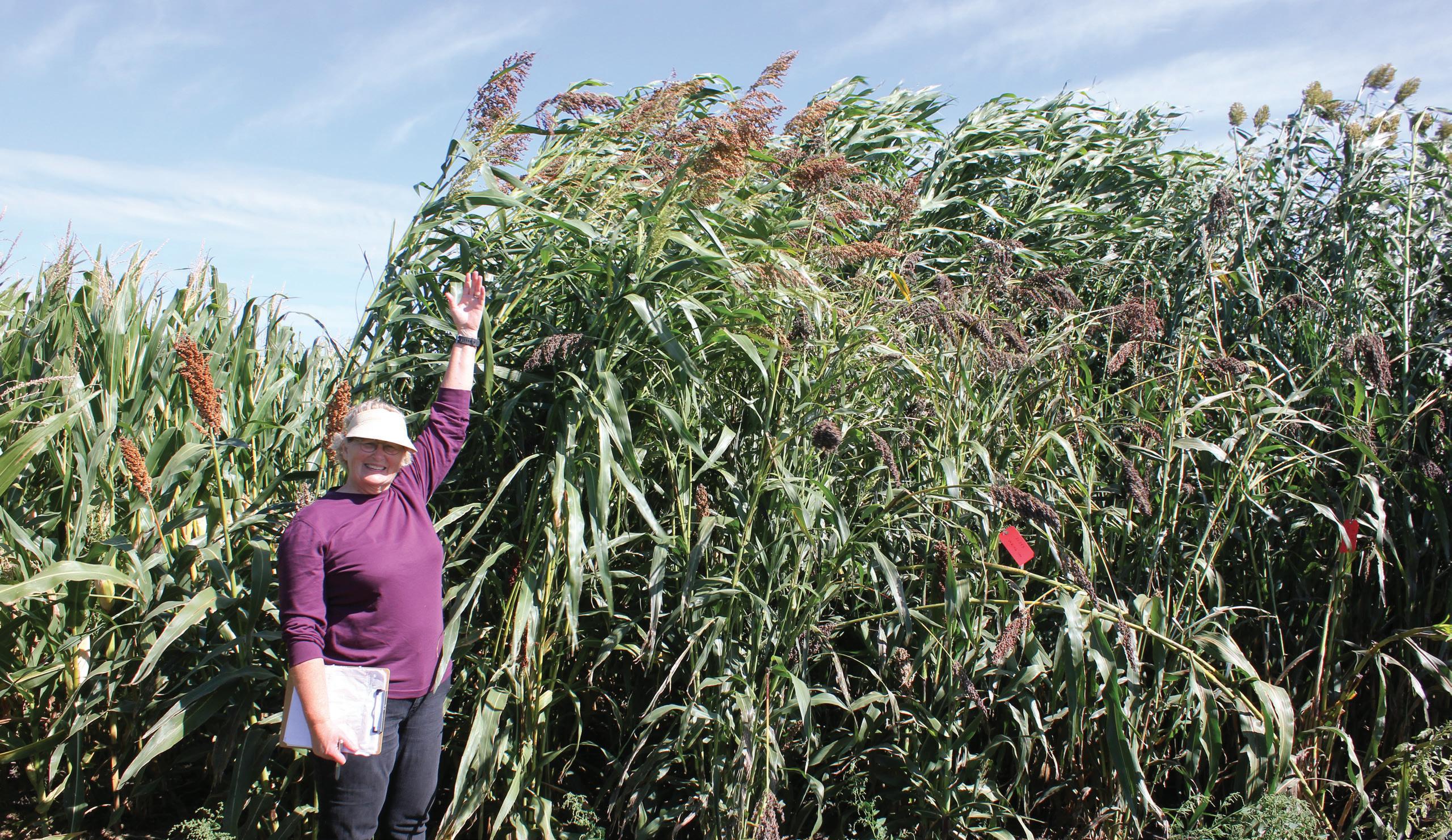
• Fast growing summer annual, excellent weed suppression
• Produces large amounts of biomass that can be incorporated into the soil as organic matter
• Very little regrowth after cutting for silage
• Excellent forage for livestock
• Wait to plant until soil is 62°F
Seeding 20-25 lbs/acre at ½" to 1" deep. Drill or increase rate to broadcast seed.
Available as: Conventional Untreated Organic
• Long-established and proven variety
• Non-BMR
• Rapid emergence and early growth; excellent for weed suppression
• Ready to harvest in 45 days
Seeding 20-30 lbs/acre at ½" to 3/4" deep. Drill or increase rate to broadcast seed.
Available as: Conventional Untreated Organic
• Member of the Linaceae plant family
• Annual, cool-season broadleaf
• Fairly drought tolerant
• Flowers attract pollinators
• Best planted with small seeded grasses and legumes
Seeding
25-50 lbs/acre at ¾” to 1½” deep. Drill or increase rate to broadcast seed.
• Member of the Polygonaceae plant family
• Quick-growing, broadleaf summer annual ready to incorporate in 35 to 45 days

• Potential for multiple plantings per year: grain crop in 70 to 90 days
• Competitive with tough weeds like giant ragweed and Canada thistle
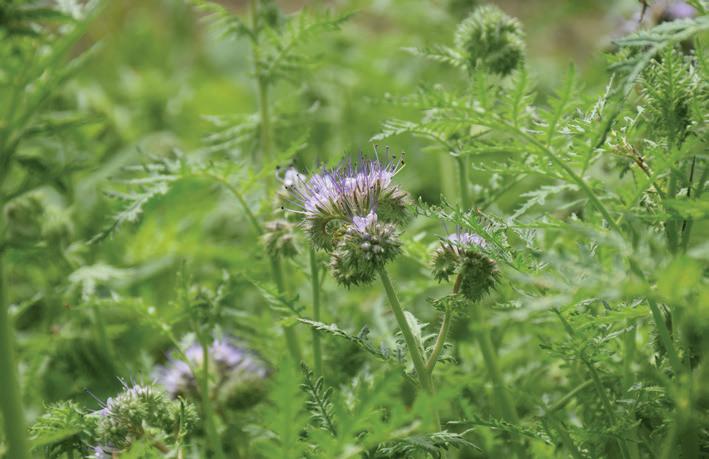
• Residue breaks down rapidly
• Mellows soil, breaks up surface compaction
• Excellent scavenger of P and other nutrients
• Thrives on nutrient-deficient soils
• Sensitive to frost, drought, excessive heat and any carryover herbicides
• Easy to terminate; do so at first sign of flowering to avoid volunteers
Seeding
50-100 lbs/acre at ½” to 1½” deep. Drill or increase rate to broadcast seed.
Available as: Conventional Organic
Available as: Conventional Brown Flax Conventional Gold Flax Organic Gold Flax
• Member of the Amaranthacea plant family
• Dual purpose plant with its large taproot and abundant top growth for forage
• Can tolerate saline soils better than other species
• Cool-season crop grows late into the fall
• Winterkills north of I-70
• To maximize taproot growth, requires 60-90 growing days before freeze
• Best used in a mix
Seeding
3-5 lbs/acre at 1” to 1¼” deep. Drill or increase rate to broadcast seed.
Available as: Conventional
• Member of the Boraginaceae plant family
• Annual broadleaf with fern-like leaves and purple blossoms
• Provides early-season soil coverage and produces abundant flowers attractive to pollinators

• Flowers 6-8 weeks after emergence
• Will winterkill at 18°F and residue breaks down quickly
• Plant early enough in the fall
• Avoid broadcasting/aerial application
• Establish at least 6-8 weeks before killing frost
Seeding
3-5 lbs/acre at ¼” to ½” deep. Drill or increase rate to broadcast seed.
Available as: Conventional

• Member of the Asteraceae plant family
• Fast-growing summer annual broadleaf for weed suppression

• Extensive root system to break up compaction
• Attractive flowers for pollinators
• Very tall providing a large amount of biomass back into the soil to increase soil organic matter
Seeding
7 lbs/acre at 1” to 3½” deep. Drill for best results.
Available as: Conventional
• Cool-season, annual legume with hollow stems
• Good biomass accumulation and N-fixation potential
• Potential early fall cover crop option after silage corn, small grains or early soybeans
• May be grazed as part of mixture
• Will likely winterkill in the Upper Midwest
• Inoculated with Pre-Vail (OMRI)
Seeding
5-8 lbs/acre at ¼” deep. Drill or increase rate to broadcast seed.
Available as: Conventional
• Fast-growing annual for quick biomass
• Fixes up to 100 lbs N at flowering
• Slightly more cold tolerant than crimson: can potentially overwinter but usually winterkills
• Excellent early fall cover crop potential after silage corn, small grains or early soybeans
• Inoculated with Pre-Vail (OMRI)
Seeding 12-15 lbs/acre at ¼” to ½” deep. Drill or increase rate to broadcast seed.
Available as: Conventional
• Multi-cut variety bred for later maturity, cold tolerance, productivity and enhanced forage quality
• Aggressive growth; establishes quickly
• Good biomass production and can fix 100 lbs N/acre at flowering
• No recorded cases of bloat
• Usually winterkills but slightly more frost tolerant than crimson clover
• Coated with NitroCoat (OMRI)
Seeding
12-15 lbs/acre at ¼” to ½” deep. Drill or increase rate to broadcast seed.
Available as: Conventional
• Rapidly growing annual clover

• Seed late summer for most biomass accumulation; can also be seeded in spring in the Upper Midwest
• Good as a cover crop overseeded into standing crops in the fall or seeded at last cultivation
• Behaves as a winter annual in southern U.S.
• Will likely winterkill in the Upper Midwest; seeding into September results in less growth before freeze-up
• Inoculated with Pre-Vail (OMRI)
Seeding
12-20 lbs/acre at ¼” to ½” deep. Drill or increase rate to broadcast seed.
Available as: Conventional Organic
• Single-cut red clover most often used as a cover crop
• Excellent choice for underseeding small grains in spring, frost seeding into winter grains, or fall seeding into standing crops
• Establishes faster and is coarser stemmed than medium red clover
• Minimal recovery after cutting. Avoid droughty soils
• Inoculated with Pre-Vail (OMRI)
Seeding
8-12 lbs/acre at ¼” to ½” deep. Drill or increase rate to broadcast seed.
Available as: Organic
• Double-cut red clover used as cover crop or forage
• Recovers better than Mammoth when clipped during small grains harvest or as forage
• Finer stemmed and better feed value than Mammoth red clover
• Fast establishing and can persist 2-3 years or be used as a oneyear plow down
• Inoculated with Pre-Vail (OMRI)
Seeding
8-12 lbs/acre at ¼” to ½” deep. Drill or increase rate to broadcast seed.
Available as:
• Low-profile, shade tolerant annual clover
• Tolerant of wet conditions
Conventional Organic
*
*
• Tall-growing, biennial legume closely related to alfalfa with high biomass and N-fixation potential
• Very drought tolerant and very winter-hardy, good scavenger of P, K, and other immobile nutrients
• Best plowdown legume for lighter and/or sandy soils
• Cut or plowdown before seed set to avoid volunteer weed issues
• Can produce 90-170 lbs N/acre
Seeding
8-12 lbs/acre at ¼” to ½” deep. Drill or increase rate to broadcast seed.
Available as: Conventional Organic
*
• Low-growing clover; good traffic tolerance and persistence
• Usable as living mulch in orchards and vegetable gardens
• Avoid dry soils
• Inoculated with Pre-Vail (OMRI)
Seeding
6-8 lbs/acre no deeper than ¼”. Drill or increase rate to broadcast seed.
Available as: Conventional
• Incredible weed suppression ability and can be grazed, unlike hairy vetch
• Will winter kill in the upper Midwest, winter hardy in zone 7A and south
• Fixes large amount of nitrogen and can be interseeded into corn at last cultivation or flown on
• Inoculated with Pre-Vail (OMRI)
Seeding
10-20 lbs/acre at ¼” to ½” deep. Drill or increase rate to broadcast seed.
Available as: Conventional
We recommend inoculating all cover crop legumes, especially if that species has never been planted on your farm.
Available Inoculants
• Alfalfa & Clover
• Birdsfoot Trefoil

• Cowpea & Sunn Hemp
• Lupine
• Pea & Vetch
• Sainfoin
* Variety Not Stated
• Leafy, speckled forage-specific pea
• Indeterminate growth habit
• Significantly more biomass than yellow grain type peas
• Best choice for forage
Seeding
75-150 lbs/acre at 2” to 3” deep.
Available as: Conventional Organic
• Tried and true dual-purpose yellow pea for grain or forage
• Upright, tall and better standing than most other varieties
• Determinate growth habit
• Broadly adapted with consistent above average yields
• Unmatched food quality because of near-perfectly round shape
• Good adaptability to wetter climates and non-traditional pea growing regions
Seeding
75-150 lbs/acre at 2” to 3” deep.
Available as: Organic
• Best used as a forage pea in cover crop mixes or forage blends
• Can provide from 90 to 150 lbs nitrogen/acre at full flowering
• Withstands temperatures as low as 10°F with minor injury
• Does not overwinter in areas colder than USDA Winter Hardiness Zone 6
• Sensitive to heat and humidity
Seeding 60-75 lbs/acre at 2” to 3” deep.
Available as: Conventional Organic
• Strong winter hardiness potential
• Excellent root system and high biomass production in the spring
• Smaller seed size; lowers seeding costs
• White flower; more digestible, and sweeter tasting to livestock compared to purple flower
Seeding 60-75 lbs/acre at 2” to 3” deep.
Available as: Conventional

• Fast growing, winter-annual legume; best fall-planted for N fixation
• Viny plant type with exceptional biomass
• Improves soil structure, scavenges P, and competes against early season weeds
• Seed in mid to late August in Upper Midwest for best overwintering
• Plant with companion crop (rye, oats, etc.) to increase chance of winter survival
• Produces hard seed; control plant before seed set. Do not seed into small grains if harvesting for marketable grain: seed is difficult to separate
Seeding
20-30 lbs/acre at ½" to 1" deep. Drill or increase rate to broadcast seed.
Available as: Conventional Organic
* Variety Not Stated
• Viny legume; annual in Upper Midwest with compound leaves and pea-like flowers
• Good growth for cover cropping if seeded early in the fall, excellent candidate for aerial application
• Less winter hardy than hairy vetch, will likely winterkill in Upper Midwest
Seeding
50-60 lbs/acre at ½" to 1" deep. Drill or increase rate to broadcast seed.
Available as: Conventional
• Viny, spring-seeded, used for plowdown and N production
• Frost and drought tolerant, high moisture efficiency
• 8-10 weeks of growth can produce 80-100 lbs N/acre
• Can cut for forage; do not feed seed to livestock
Seeding
60-70 lbs/acre at ½" to 1" deep. Drill or increase rate to broadcast seed.
Available as:
• Tall, bushy annual thrives in cool & wet soils
• Not tolerant to heat & drought
• Somewhat frost tolerant
• Can produce 3.5-6 tons/A DM
• Can fix up to 140 lbs N/acre
• Large taproot breaks up compaction
• Large seed; slow to emerge - plant early
• Use for silage/hay; good forage quality
Seeding
• Warm-season legume
• Selection of cowpea with upright, bush-type growth
• Excellent tolerance to sandy soils and droughty conditions
• Well suited to all soil types and a wide range of pH
• Less overall biomass than Iron and Clay cowpeas in southern zones
• Plant in summer at soil temp >65°F
• Seed & biomass is toxic to horses
Seeding
60-75 lbs/acre at ½” to 1” deep. Drill or increase rate to broadcast seed.
Available as: Organic
• Vigorous growing warm-season legume
• Thrives in hot, wet conditions
• Excellent drought stress tolerance; can fix up to 150 lbs N/acre
• Ready to plowdown 60-90 days after planting
• Plant in summer at soil temp >65°F
Conventional
• Seed & biomass is toxic to horses
Seeding
50-75 lbs/acre at ½” to 1” deep. Drill or increase rate to broadcast seed.
Available as: Conventional
• Warm-season annual legume
• Excellent heat and drought tolerance
• Good nitrogen fixer and can be grazed
• Best adapted to sandy loam soils and dry conditions
Seeding
100-150 lbs/acre at 1” to 3” deep. Drill or increase rate to broadcast seed.
Available as: Conventional
• Short-growing, cool season legume
• Very good drought and frost tolerance
• Smaller seed size ideal for aerial application into standing crops
• Will winterkill in Upper Midwest
• Suited for all soil types including dry soil
Seeding
40-50 lbs/acre at ½” to 2” deep. Drill or increase rate to broadcast seed.
Available as: Conventional Organic
15-20 lbs/acre at 1” to 2” deep. Drill or increase rate to broadcast seed.
Available as: Conventional
• Tall-growing, warm-season annual legume; tremendous biomass and N-fixing capacity
• Quick growing, very heat and drought tolerant; has the potential to put on over 5,000 lbs. of biomass in 60 days. Thrives on poor soils
• Plant when soil temps are >65°F. Requires same inoculant as cowpeas
• Young stems & leaves rich in protein; initial growth excellent for grazing
• Stop grazing when plants began to flower; flowers and seed can be toxic to livestock
Seeding
15-20 lbs/acre at ½” to 1” deep. Drill or increase rate to broadcast seed.
Available as: Conventional
SEEDING RATE: NR = Not Recommended
PREDICTED HARDY: ID = Insufficient Data • NFT = Not Frost Tolerant
*Highly variable on winter growing conditions, planting date, snow cover, etc Cover Crop Goals
COVER CROP GOALS & TOLERANCES:

